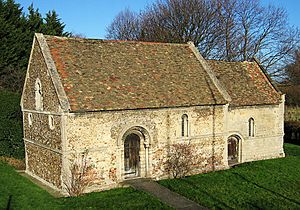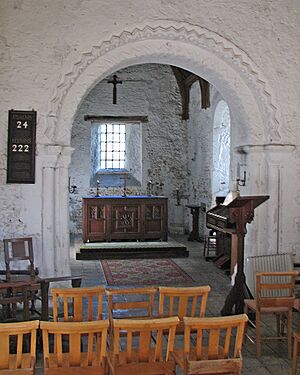Leper Chapel, Cambridge facts for kids
The Leper Chapel is a very old building in Cambridge, England. It's also called the Leper Chapel of St Mary Magdalene. This historic chapel was built around the year 1125. It stands on the east side of Cambridge, near Newmarket Road.
Long ago, the chapel was part of a hospital for people with leprosy. This hospital was outside the city, on the road to Bury St Edmunds. While some parts of the chapel's east wall are original, most of it was rebuilt in the 1200s. It still shows many features of Romanesque architecture, which was popular a long time ago.
Contents
History of the Leper Chapel
The Leper Chapel has a long and interesting history. It started as a place of care for people with leprosy. Over time, its purpose changed quite a bit.
Early Days and Royal Support
In 1199, King John gave the chapel special permission. This allowed them to hold a three-day fair. The fair's goal was to raise money. This money would help support the people with leprosy at the hospital.
The fair began in 1211. It happened around September 14th, which is the Feast of the Holy Cross. The fair took place on Stourbridge Common. This area is behind the chapel and goes down to the River Cam.
The Famous Stourbridge Fair
The fair at Stourbridge Common grew to be very important. It became the largest Medieval fair in all of Europe! It made so much money that the priest's job at the Leper Chapel became one of the richest in the English church.
However, the leper hospital stopped taking new patients in 1279. The few remaining lepers moved to a new place near Ely. This meant the chapel no longer needed to hold regular church services. The priest's job became a "sinecure," meaning it paid well but involved little work.
Changes Over the Centuries
In 1546, the chapel was officially closed. Its property was taken over by the Crown (the government). The town of Cambridge and the University of Cambridge then argued over who controlled the fair.
Queen Elizabeth I eventually decided in favor of the town. However, the University still had rights to check weights, measures, and the quality of goods sold. After this, the chapel was used to store market stalls for the next fair. In the 1700s, it even served as a pub during the fair!
After 1751, no more religious services were held there. In 1783, it was advertised for sale as just a storage shed. The big fair was finally stopped in 1933. However, it was brought back in the 2000s and is now held every year at the Leper Chapel.
Restoration and Modern Use
In 1816, a man named Thomas Kerrich bought the chapel. He then worked to restore it. Kerrich later gave the chapel to the University of Cambridge. In 1951, the University gave it to the Cambridge Preservation Society.
Today, the chapel is a Grade I listed building. This means it's a very important historic site. It is cared for by Cambridge Past, Present and Future (CPPF). The chapel is now used for worship again. It is part of the Parish of Christ the Redeemer.
The "Friends of the Leper Chapel" group started in 1999. They help promote the chapel for education, cultural events, and worship. The chapel also hosts many local activities. These include plays and performances by a local theatre group called In Situ.
See also
- Barnwell Priory, founded around 1092
- St Bene't's Church, built in 1033
- Holy Sepulchre, Cambridge or Round Church, from 1130
- School of Pythagoras, dating from about 1200



